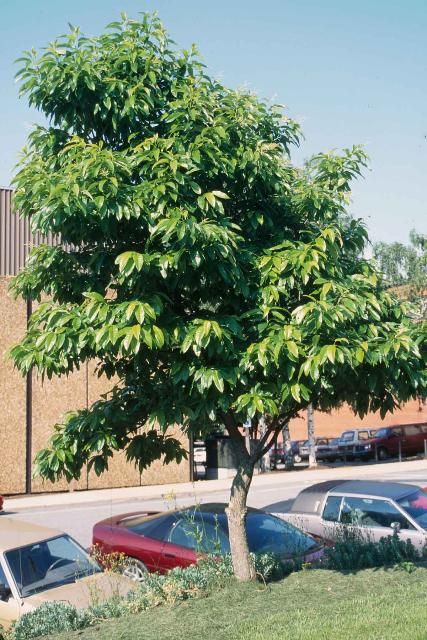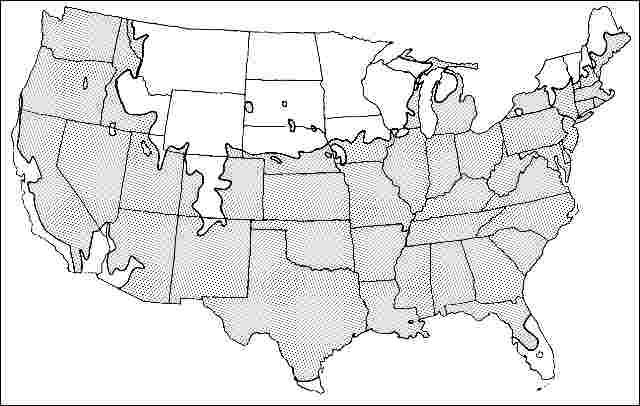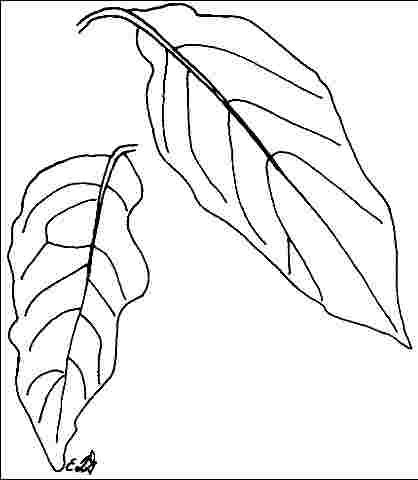Introduction
Sourwood usually grows as a pyramid or narrow oval with a more or less straight trunk at a height of 25 to 35 feet but can reach 50 to 60 feet tall with a spread of 25 to 30 feet. Occasionally young specimens have a more open spreading habit reminiscent of Redbud. Leaves are dark, lustrous green and appear to weep or hang from the twigs. Branches droop toward the ground forming a graceful outline when planted as a single specimen. The branching pattern and persistent fruit make the tree interesting in the winter. The mid- to late-summer flowers are borne in terminal clusters of racemes which curve upward, creating a graceful effect at flowering time. The fall color is a striking red and orange which is rivaled by only a few other trees such as Blackgum, Chinese Pistache, the pears, and Chinese Tallowtree. There are few sights that are as striking as a row of Sourwood in fall color.

Credit: Ed Gilman
General Information
Scientific name: Oxydendrum arboreum
Pronunciation: ock-sih-DEN-drum ar-BORE-ee-um
Common name(s): Sourwood, Sorrel-Tree
Family: Ericaceae
USDA hardiness zones: 5A through 9A (Fig. 2)
Origin: native to North America
Invasive potential: little invasive potential
Uses: specimen; highway median; shade
Availability: somewhat available, may have to go out of the region to find the tree

Description
Height: 40 to 60 feet
Spread: 25 to 30 feet
Crown uniformity: irregular
Crown shape: pyramidal, oval
Crown density: dense
Growth rate: slow
Texture: medium
Foliage
Leaf arrangement: alternate (Fig. 3)
Leaf type: simple
Leaf margin: serrulate, entire, undulate
Leaf shape: oblong, lanceolate
Leaf venation: pinnate, brachidodrome
Leaf type and persistence: deciduous
Leaf blade length: 4 to 8 inches
Leaf color: green
Fall color: red, orange
Fall characteristic: showy

Flower
Flower color: white/cream/gray
Flower characteristics: showy
Fruit
Fruit shape: oval
Fruit length: less than .5 inch
Fruit covering: dry or hard
Fruit color: brown
Fruit characteristics: does not attract wildlife; not showy; fruit/leaves not a litter problem
Trunk and Branches
Trunk/bark/branches: branches droop; not showy; typically one trunk; thorns
Pruning requirement: little required
Breakage: resistant
Current year twig color: green, reddish
Current year twig thickness: thin, medium
Wood specific gravity: unknown
Culture
Light requirement: full sun, partial sun or partial shade
Soil tolerances: clay; sand; loam; acidic; well-drained
Drought tolerance: moderate
Aerosol salt tolerance: moderate
Other
Roots: not a problem
Winter interest: yes
Outstanding tree: yes
Ozone sensitivity: unknown
Verticillium wilt susceptibility: unknown
Pest resistance: resistant to pests/diseases
Use and Management
The tree grows slowly, adapts to sun or shade, and prefers a slightly acid, peaty loam. The tree transplants easily when young and from containers of any size. Sourwood grows well in confined soil spaces with good drainage making it a candidate for urban plantings but is largely untried as a street tree. It is reportedly sensitive to air pollution injury. Irrigation is required during hot, dry weather to keep leaves on the tree. Reportedly not highly drought-tolerant, but there are beautiful specimens in USDA hardiness zone 7 growing in the open sun in poor clay with no irrigation.
Pests
Pests are usually not a problem for Sourwood. Fall webworm can defoliate portions of the tree in summer and fall but usually control is not needed.
Diseases
Twig blight kills leaves at the branch tips. Trees in poor health seem to be more susceptible. Prune out infected branch tips and fertilize. Leaf spots can discolor some leaves but are not serious other than causing premature defoliation.